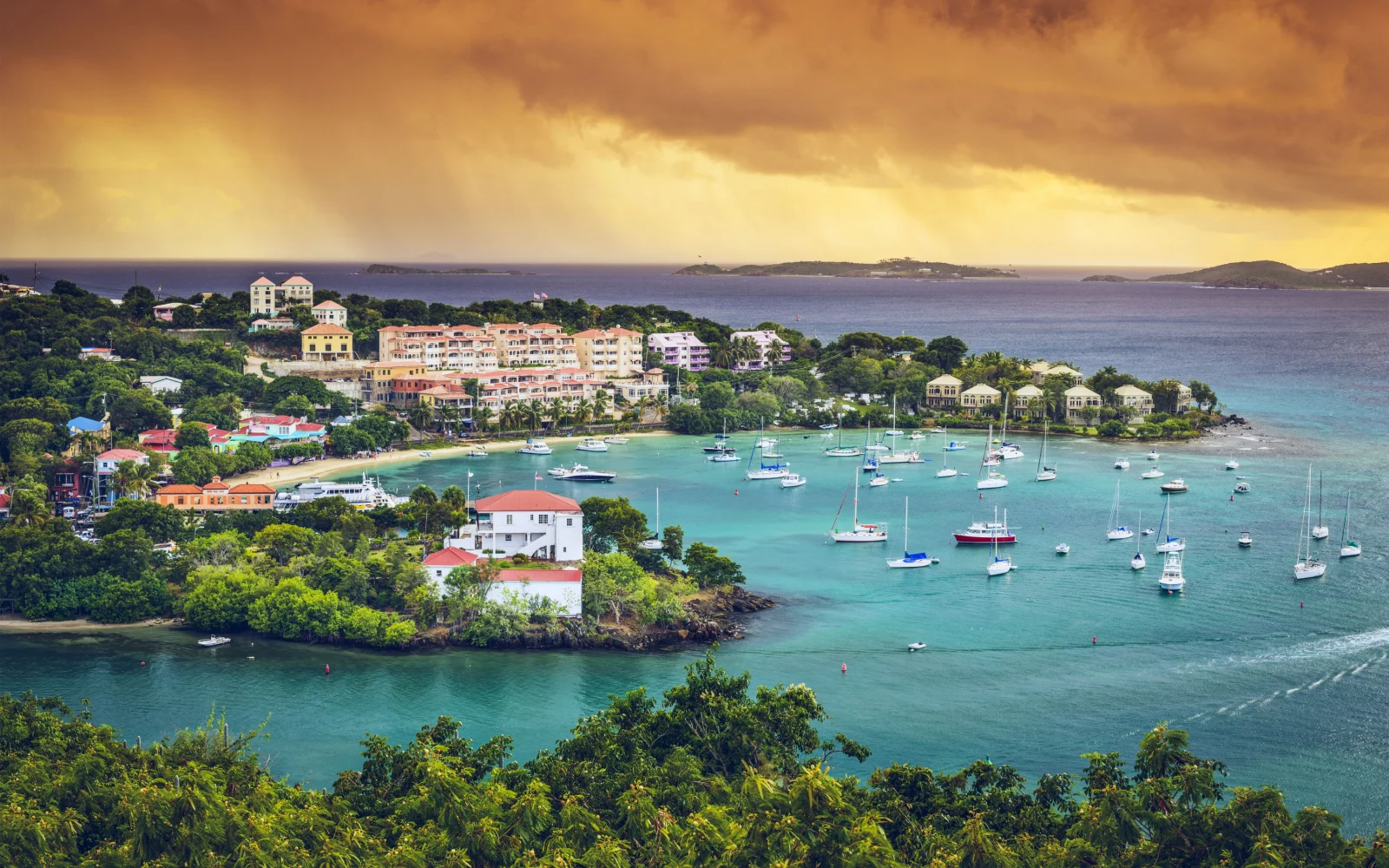What's the best time to visit St. John?
The best time to visit St. John is between December and April (March is markedly more expensive). Dry, sunny weather with highs in the low 80s makes this the perfect time to explore St. John’s tropical beaches, snorkel, hike, and enjoy Caribbean fare at local restaurants and waterfront bars. It’s also a great time to visit the other U.S. Virgin Islands, like St. Thomas and St. Croix, and attend festive Carnival celebrations.
Of the 4 U.S. Virgin Islands (USVI), St. John is the one that’ll win your heart. Amazingly scenic and unspoiled with just the right amount of development to make your trip fun and exciting, discovering the best time to visit St. John can be the difference between a blissful week on sunny shores or a rainy trip with tropical storms brewing.
St. John is delightfully small and easy to explore — just 3 miles wide and 8 miles long. You won’t find traffic lights, airports, or chain stores and restaurants here, just long-standing spots big on local charm (it’s known as Love City) and completely enveloped in the natural beauty that the island offers.
St. John is especially popular with U.S. citizens because no passport is required to visit. But you’ll feel worlds away on this tropical island, covered in lush rainforest, ringed by white sand beaches, and dotted with small eateries, bars, and shops that give it a rural, welcoming feel.
Over half of the island is part of the Virgin Islands National Park, a totally undeveloped and naturally gorgeous 5,500-acre oasis with hiking trails, beaches, and historic sites. It spans from the verdant mountains to the coast with quiet beaches (some you have to hike to for amazing views).
Famous for its world-class snorkeling, pristine beaches, lush rainforests, abundant wildlife and marine life, and laid-back vibes that remind you you’re on island time, St. John should be on your shortlist if you’re headed to the Caribbean. But what’s the best time to visit?
We’ll show you the right time of year to go, no matter what you’re looking for in your St. John trip: Great weather, low prices, smaller crowds, or which months to avoid. For each season, we’ll show you things to do, weather trends, hotel and flight prices, festivals and events, and places to eat and enjoy the nightlife.
Whether you’re coming for endless beach days with a rum cocktail in hand, adventurous snorkeling and sailing excursions, or hiking through tropical forests, we’ve got you covered with all the trip-planning recommendations you need. Let’s take a look at the best time to visit St. John.
The Overall Best Time to Visit St. John
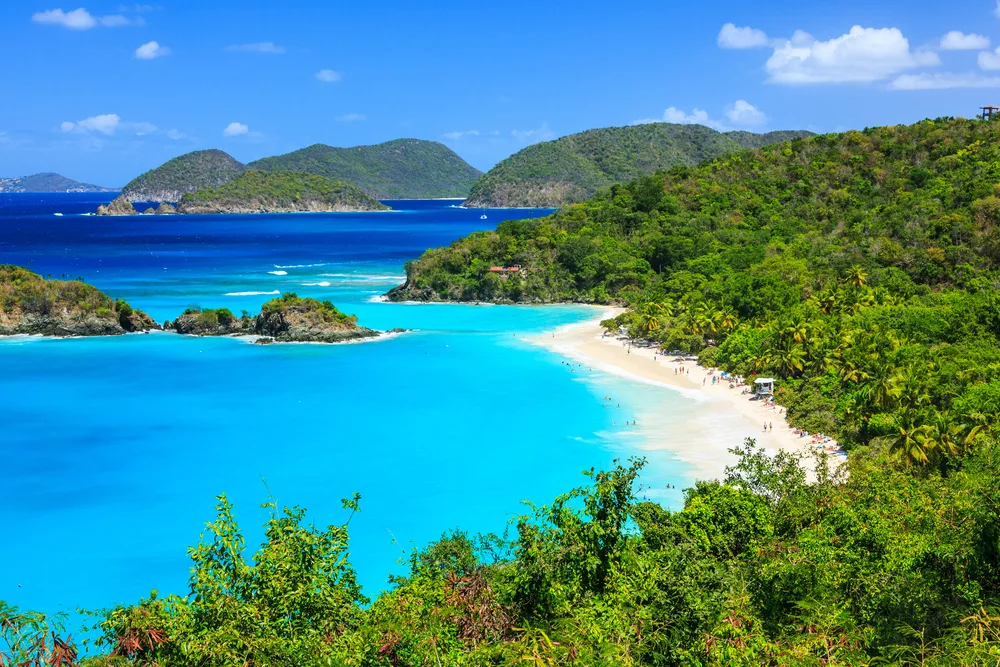
SC Stock/Shutterstock
The best time to visit St. John is between December and April, the blissful peak season with dry weather, warm sunshine, and tons of island-wide events and festivals to check out in between beach time and snorkeling.
The island is at its liveliest during these months: The peak tourism season when events are popping, beaches are busy, and outdoor activities, from snorkeling to hiking, are at their best with minimal rain and balmy temperatures that feel pleasant, not hot.
The weather in St. John is absolutely blissful this time of year. It’s the dry season with highs in the low 80s and the fewest rainy days of the year:
- December: 75–84°F; 6 rainy days
- January: 74–83°F; 4 rainy days
- February: 74–84°F; 3–4 rainy days
- March: 74–84°F; 3–4 rainy days
- April: 76–85°F; 5–6 rainy days
There’s no limit to what you can do on the island during these idyllic months. Some of the best spots for snorkeling are Maho Bay with tons of sea turtles not far from the shore, Trunk Bay’s underwater snorkel trail with signs to point you in the right direction, and Salt Pond (it can be really busy this time of year).
Hang out on some of the island’s best beaches this time of year, like Hull Bay Beach, Platform Beach, and Neltjeberg Beach (a true hidden gem) to lounge on the sand, swim, and take your pick of water sports, dining, and bars right on the water.
This is a great time of year for a sailing charter, where you’ll feel the ocean breeze as you travel to some of the best snorkeling spots around the island and get to experience the scenery from a new perspective (lunch is often included).
If you like hiking, Ram Head Trail (2.6 miles) leads to rocky Salt Bay Beach, Blue Cobblestone Beach, and great views of cacti fields, the Caribbean Sea, and neat rock formations. Since the parking lot is small, this is the best time of year to hike here with fewer crowds.
There are plenty of restaurants on St. John with Caribbean fare, seafood, steak, pizza, and more. Ekaete Pink Corner in Coral Bay is our favorite for cash-only local eats — succulent oxtail, fish and fungi (foon-ji), curries, and more.
The BBQ at Uncle Joe’s and ocean fare at Woody’s Seafood Saloon in Cruz Bay are worth checking out for laid-back dining, while fusion food at Morgan’s Mango (Kenney Chesney frequents this spot — try the key lime pie) and upscale ZoZo’s are great for something a bit more refined.
We grabbed Google Hotels and Skyscanner data to show you what you can expect to pay for your hotel and round-trip flight to St. Thomas (then take a 20-minute ferry or water taxi over to St. John):
- December: $517/night; flights from $442
- January: $531/night; flights from $414
- February: $570/night; flights from $447
- March: $619/night; flights from $442
- April: $509/night; flights from $188
March is the most expensive month of the year on St. John, so we’re less inclined to visit during this time — you’ll pay top dollar for your hotel room, flight, and still have the peak season crowds to deal with (but the weather’s great).
There are always festivals and events happening on the island between December and April, with everything from live music at restaurants and bars to farmer’s markets and annual celebrations like these:
- Bizarre Bazaar (Dec) features holiday-themed arts and crafts, local music, food trucks, and more at the Coral Bay Caribbean Oasis Event Center
- Holiday Events (Dec) from the All-Island Holiday Party/St. John Prom at Mongoose Junction to the annual Ugly Sweater Party at The Tap Room at St. John Brewers ring in Christmas cheer in a tropical setting
- St. John Arts Festival (Feb) in Cruz Bay features a children’s choir, film screenings, art, music, and dance performances
- Folk Life Festival (Feb) celebrates Black History Month with cultural showcases and educational lectures at the National Park playground in Cruz Bay
- Virgin Islands Jam Fest (Mar) is a fun and funky festival featuring local jam bands and musicians with hundreds in attendance at the Windmill Bar in Cruz Bay
- Transfer Day (Mar 31) commemorates the day the Virgin Islands was transferred from the Danish to the U.S. with parades, food, music, and celebrations around St. John
- St. Thomas Carnival (Apr–May) happens on the neighboring island if you’re looking for even bigger celebrations with masquerade costumes, loud music, and food and drink booths galore
While you won’t find many deals on flights or hotels during this near-perfect peak season period, if you wait until April to visit, you’ll save some money on your flight. It’s the second-cheapest month to fly to St. Thomas, especially toward the middle and end of the month.
Cheapest Time to Visit St. John
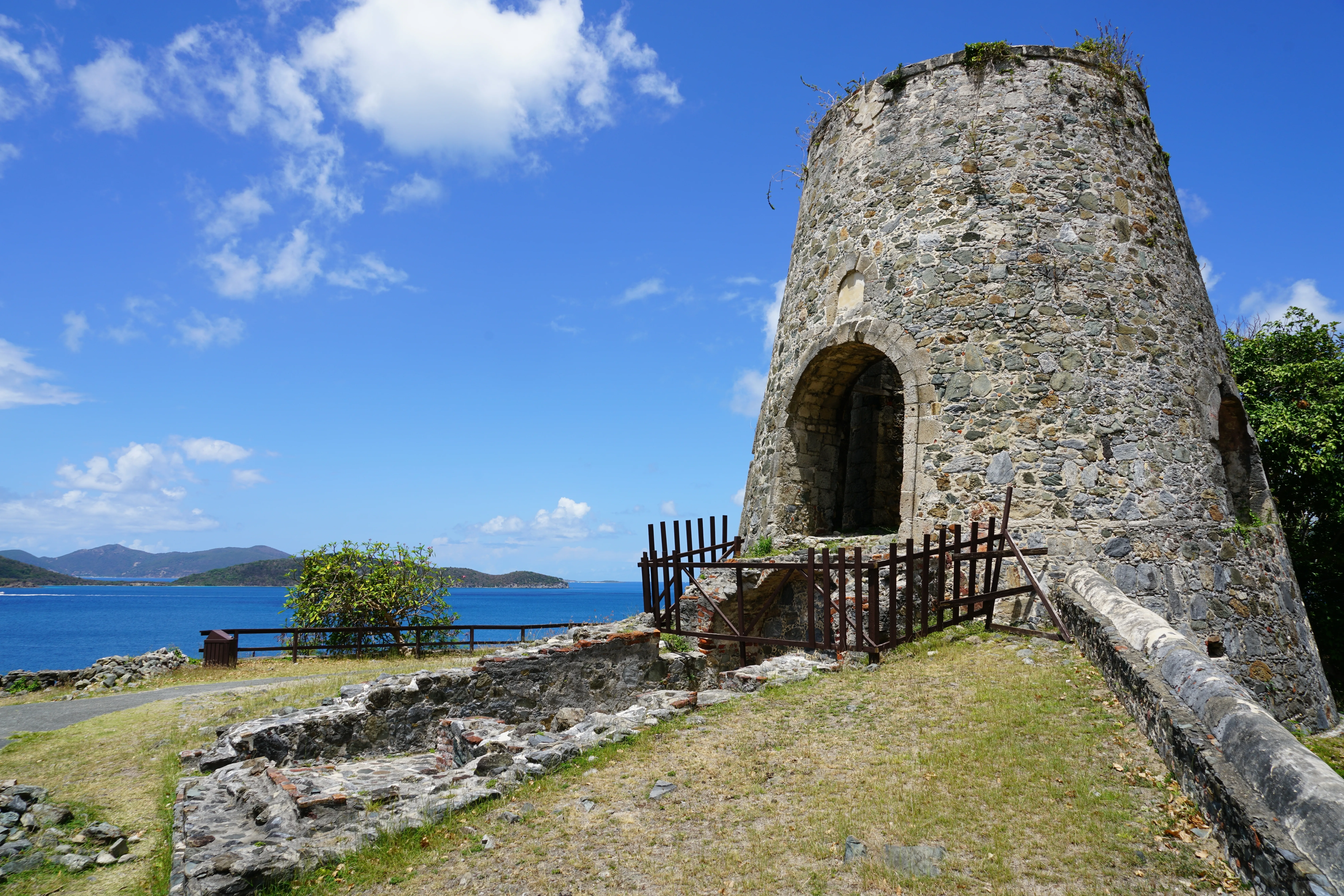
View of historic Annaberg Sugar Plantation ruins in Virgin Islands National Park 2017/EQroy/Shutterstock
August through October is the cheapest time to visit St. John if you’re sticking to a tight budget. July and November can be similarly cheap to visit. You’ll find hotels priced under $400/night on average during these months.
Why is it cheaper to visit St. John between August and October? It’s the rainy hurricane season, when the weather doesn’t cooperate with beach, hiking, snorkeling, and sailing plans as well as during the peak season. But you’ll save a bundle if you chance it and visit this time of year.
- August: 79–89°F; 9 rainy days
- September: 79–89°F; 11–12 rainy days
- October: 78–88°F; 11 rainy days
September is a little wetter than August and October, but none of these months typically see solid days of rain — St. John just experiences more frequent showers and storms. That means you can still find dry weather for hitting the beach, snorkeling, hiking, walking through town, and exploring historic sites.
You should note that hurricane concerns are higher this time of year, with about 78% of storms happening during this 3-month period when prices are lowest. Some major hurricanes, like Irma, Marilyn, and Hugo have hit St. John and the USVI during September.
That helps explain why hotel rates are so much cheaper this time of year and should be considered if you’re thinking about visiting. You’ll find not just the cheapest hotel rooms, but also one of the cheapest months to fly (August) this time of year:
- August: $388/night; flights from $199
- September: $391/night; flights from $231
- October: $358/night; flights from $264
You’ll find plenty of things to do on St. John this time of year in between the rain showers. Head out to snorkel at Pelican Rock in Hansen Bay. It’s technically a private beach, but the owners open it up for snorkeling during the day at a low cost around $5 per person.
Little Lameshur Beach and Gallows Point are other great, secluded spots for snorkeling. For an even more immersive sea experience, take a Scuba diving class and head out on a diving excursion for a few hours.
Eagle Shoals is one of the best spots with the sponge-lined Cathedral underwater cave, shallow waters with rays and turtles, and chances to spot dolphins and whales.
St. John Provisions is our favorite spot for coffee and breakfast (try the everything bagels, the best ever) and pick up a sandwich to-go for lunch later on (the BLT is incredible). Grab drinks at Windmill Bar, Beach Bar, or check out Miss Lucy’s for open mic night!
The Banana Deck in downtown Cruz Bay serves excellent steaks, burgers, and seafood. Dave and Jerry’s Island Steakhouse has great dry-aged steaks and fresh fish. For a taste of home, head to Ronnie’s Pizza an’ Mo’ in Cruz Bay for a slice, calzone, wings, beer, and desserts.
As far as annual festivals and events go, there’s less going on this time of year as the tourism season slows down considerably. But you’ll still find some local festivities to check out:
- Creole Day/Jounen Kwéyòl (Oct 30) at Flavour’s Nightclub brings Caribbean creole music, food, and dancing to one of the island’s most popular nightclubs
- Halloween Costume Contests (late Oct) at St. John Brewers’ Tap Room, the Beach Bar, and Salty Mongoose Pizza & Rum Bar give prizes for the most unique and impressive costumes with spooky drink specials
If you’re concerned about hurricanes, July and November are similar in price (about $395–$397/night) to August–October. While they’re still part of the hurricane season, fewer major storms tend to happen in these months.
Least Busy Time to Visit St. John
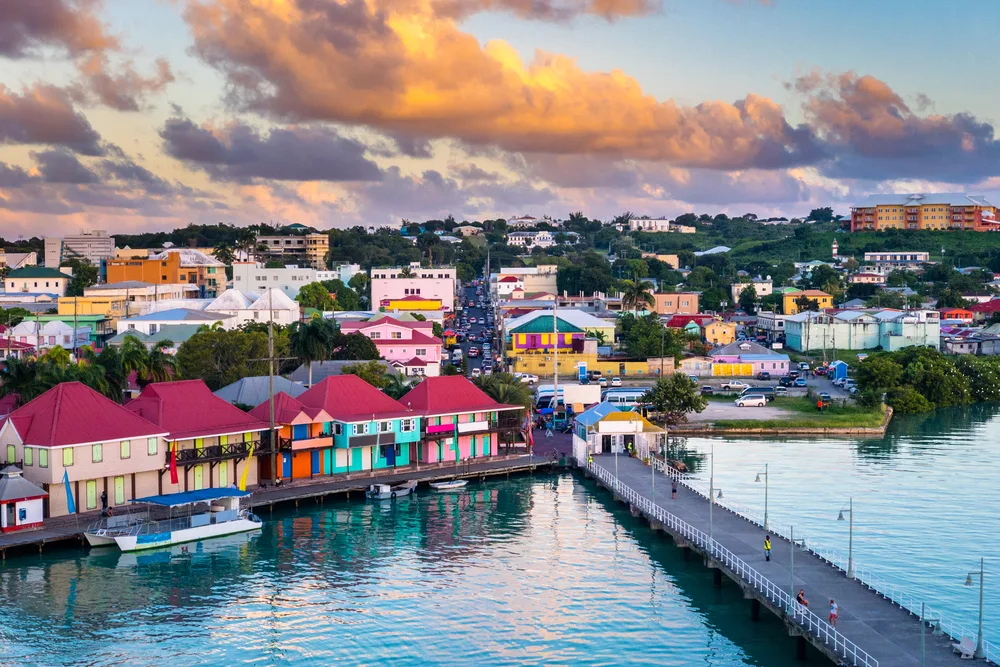
Sean Pavone/Shutterstock
May through July is the least busy time to visit St. John. After the peak season ends in April, tourism slows down and the island is quiet with more opportunities for serene beach days, hiking on uncrowded trails, and enjoying water sports.
There’s a little more rain than during the dry peak season, but conditions are still favorable for enjoying all the outdoor adventure and tranquility (whatever floats your boat!) St. John has to offer.
- May: 78–87°F; 9–10 rainy days
- June: 79–88°F; 7 rainy days
- July: 79–89°F; 7–8 rainy days
With warmer temperatures than the dry season and 7–10 days of rain each month, it’s hot, humid, and wet at times on St. John between May and July. But crowds are nonexistent, especially in June — the quietest month on the island year-round.
Hotel prices aren’t at their lowest this time of year, but they’re well below peak season prices (check out Google Hotels rate data below). It helps that May is the cheapest month to fly to the U.S. Virgin Islands and July is one of the cheapest months to stay on St. John!
- May: $411/night; flights from $134
- June: $413/night; flights from $215
- July: $397/night; flights from $268
Hit up farmer’s markets around the island, like Love City Market and Calabash Market (eastern side of Coral Bay) and Dolphin Gourmet Market (southwestern side of the island) to taste local produce, pastries, specialty Caribbean snacks and dishes, and buy handicrafts and souvenirs.
Take a ferry over to St. Thomas for wild Carnival celebrations in early May, check out the St. John Festival/Carnival in late June and early July, and stick around for Independence Day parades, food fairs, and fireworks.
Reef Bay Trail (3 miles) in Virgin Islands National Park is a challenging trail that leads through old-growth forest, a waterfall that only cascades this time of year (rainy season), ancient petroglyphs, a swimming beach, and the Annaberg sugar plantation (take a self-guided tour) with slave quarter ruins and a windmill.
Eat adventurously with Roti King at the Lumberyard by the port for Caribbean roti (meaty or veggie curry wrapped in a thin dough) homemade chutney, pates, johnny cakes, and burgers. Afterward, walk to St. John Scoops for homemade ice cream — some infused with rum!
Hit up some of the bars and breweries for delicious rum-soaked cocktails, beer, and good times! Bajo del Sol has a great rum selection and cocktails with an onsite art gallery. St. John Brewers is the spot for craft beer, soda, and seltzers.
Here’s a look at some of the annual events you can look forward to on St. John between May and July:
- St. Thomas Carnival (Apr–May) happens on the neighboring island if you’re looking for even bigger celebrations with masquerade costumes, loud music, and food and drink booths galore
- Beach-to-Beach Power Swim (May) at Maho Bay begins on Memorial Day weekend with individuals and teams racing to swim to Cinnamon Bay, Trunk Bay, or the far-out Hawksnest Bay
- St. John Festival (Jun–Jul) is a multi-day Carnival festival of St. John culture, food, music, and art with a carnival-style parade, historical presentations, a children’s village, boat races, torch light parade, fireworks, and more
- Independence Day Celebrations (Jul 4) are packed with food trucks, calypso music, dancing, and a big parade to cap it all off with a fireworks show just after Carnival
While it’s the start of the rainy hurricane season and temperatures are warmer than the peak season, May through July can be a great time to visit if you’re looking for less-crowded conditions and want to feel like you’re experiencing a more local, authentic St. John.
Worst Time to Visit St. John
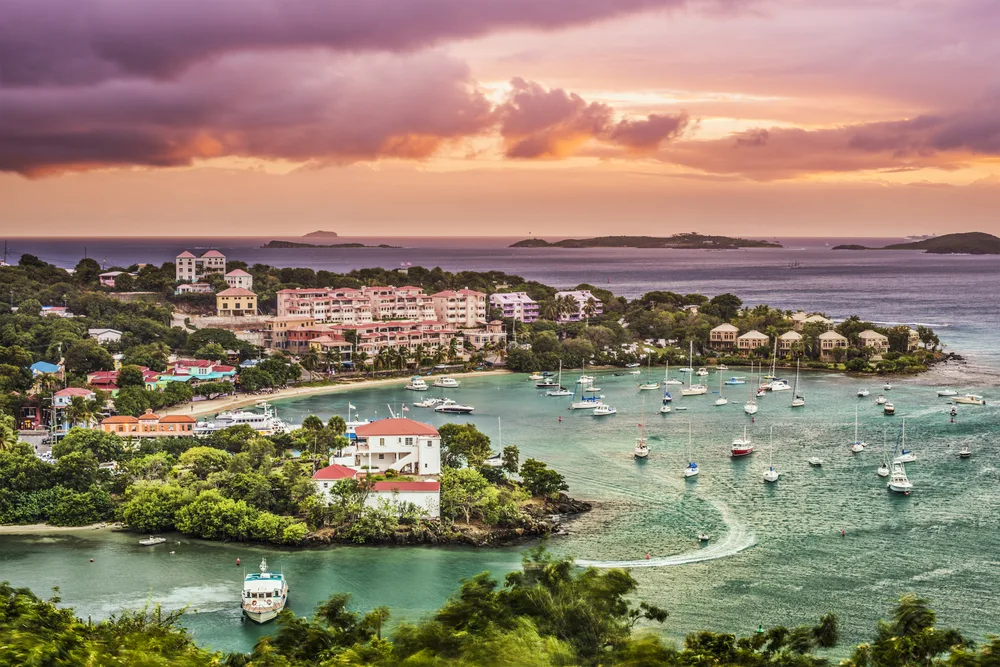
Sean Pavone/Shutterstock
The worst time to visit St. John is during March, the most expensive month for hotels and flights, and September, the peak month of hurricane season with lots of rain.
Since St. John is a year-round destination, there aren’t many periods when you can’t enjoy the island. But September and March offer the worst conditions for people seeking idyllic weather or affordable prices.
March is great in terms of weather on St. John — sunny skies, minimal rain, and highs in the low 80s. September is a different story, with more hurricanes historically hitting this month, up to 12 rainy days, and cloudy skies with highs close to 90°F.
- March: 74–84°F; 3–4 rainy days
- September: 79–89°F; 11–12 rainy days
While March seems to be a much better choice for a visit than September, it’s got issues of its own: The cost. March is a peak season month with lots of visitors, so the prices on hotels and flights reach their annual peak this time of year.
- March: $619/night; flights from $442
- September: $391/night; flights from $231
September, on the other hand, is one of the cheapest months to visit St. John. But considering the risk of major hurricanes and tropical storms along with the increased number of rainy days, it’s far from being the best time to visit the island.
If you find yourself traveling to St. John in March or September, you will be able to find fun things to do and events going on — especially in March.
March is perfect for spending time on St. John’s white sand beaches, exploring the national park’s hiking trails, fishing spots, and snorkeling cays, and checking out historic sites and ruins in and around the park.
Take in the nightlife in March around Cruz Bay, kayak through the mangroves, or take a Scuba diving course and get to know the marine life beneath the waves.
In September, you’ll be able to squeeze in outdoor fun between the rains, which don’t usually last all day. It’s a nice month to explore the sugar plantation ruins in Virgin Islands National Park, snorkel the underwater trail at Trunk Bay, or hit the art galleries and museums in Cruz Bay.
March events like Transfer Day parades and celebrations and the Virgin Islands Jam Fest can be fun to check out. In September, you’ll find local restaurants and beachfront bars with live music, karaoke and open mic nights, and pop-up events with food trucks and art fairs.
Neither of these months offer the complete package for a St. John trip; March is incredibly expensive and September’s weather is the worst of the year here. But the beautiful beaches, good food, friendly locals, and lush national park can be the saving grace of both months.
St. John by Month: What to Expect
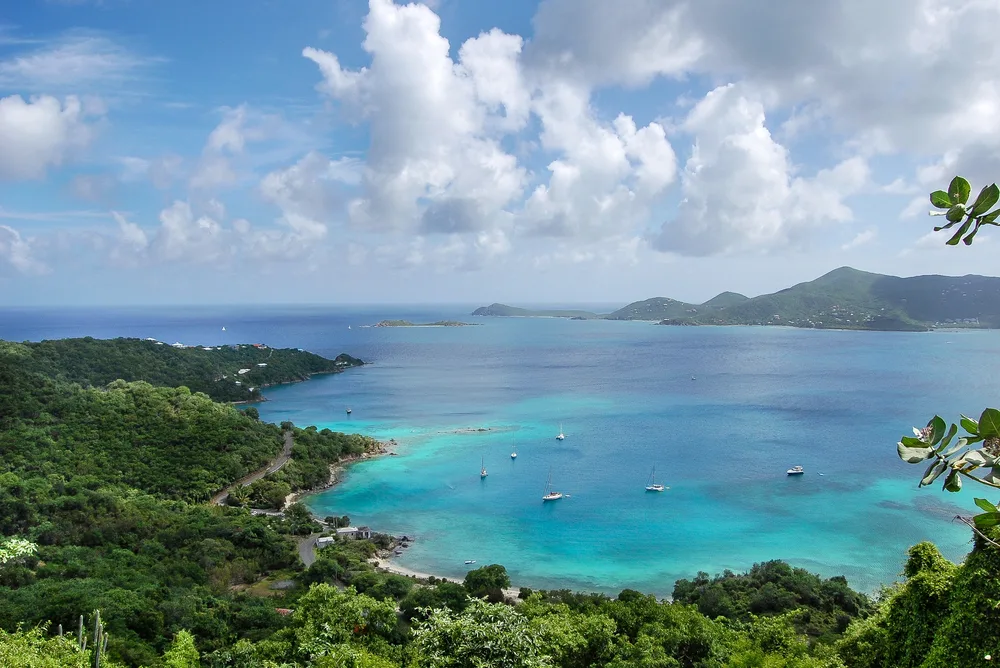
Evan Austen/Shutterstock
St. John experiences pleasant weather almost year-round with warm temperatures, but seasonal rainfall, price fluctuations, and festivals can help you better pinpoint the best time to visit St. John. Take a look at what you can expect each month of the year below.
January
Dry, sunny January is pleasant and mild with highs around 83°F and just 4 rainy days during the month. As part of the peak season, beach conditions are perfect but it’s a busy month to visit with higher hotel and flight prices — around $531/night on average and flights starting at $414 round-trip from the U.S.
February
February continues the peak season with dry weather (3–4 rainy days) and highs around 84°F for pleasant conditions that are just right for beach days and snorkeling trips. Hotels are expensive, around $570/night on average, and round trip flights start around $447. Check out the St. John Arts Festival and the Folk Life Festival this month.
March
March is the busiest month of the dry peak season and the prices show it. With highs around 84°F and 3–4 rainy days, everyone wants to visit in March so hotels cost around $619/night on average. Flights start at about $442 round trip, but the Transfer Day celebrations and Virgin Islands Jam Fest can be fun to attend this month.
April
April sees the busy peak season finally winding down as a little more rain (5–6 rainy days) enters the picture and daily high temperatures begin to heat up to the mid-80s. The St. Thomas Carnival on the neighboring island is a huge event this month. Hotels cost $509/night on average with some of the lowest flight prices ($188+ round trip) of the year.
May
May is a nice quiet period just after the peak season but ahead of the coming rainy hurricane season. Airfare is cheapest this month and hotels cost around $411/night on average with 9–10 rainy days and highs reaching around 87°F. Strong swimmers should check out the Beach-to-Beach Power Swim on Memorial Day weekend.
June
June marks the start of hurricane season and sees around 7 rainy days with hot temperatures (highs around 88°F) and humidity. This is when the famous St. John Festival/Carnival happens at the end of the month, but it’s a less-busy month overall. Hotels charge around $413/night on average and flights are affordable at $215+ round trip.
July
July is a quiet, less busy time to visit St. John, aside from the big Independence Day celebrations on July 4 (food trucks, parades, fireworks, and more). With highs around 89°F and 7–8 rainy days, the weather is hot and wet. Hotels cost an average $397/night and flights can be found as low as $268 round trip.
August
Marking the peak period of hurricane season and one of the cheapest months to visit St. John, August is hot (highs around 89°F) and wet (9 rainy days) with higher chances of tropical storms and hurricanes. Hotels drop their rates to about $388/night on average, while flights are some of the cheapest of the year (starting at $199 round trip).
September
September continues the peak hurricane season with the highest number of historic hurricanes making landfall or brushing close to St. John this month. Highs around 89°F and up to 12 rainy days mean the weather isn’t great, but hotel prices average about $391/night and flights start at $231 round trip this month.
October
Marking the end of the peak hurricane season, October is less active with tropical storms and major hurricanes. But there are still around 11 rainy days and highs around 88°F as things begin to cool off. Expect to pay around $358/night for your hotel and upwards of $264 for a round trip flight. Check out Halloween costume contests and Creole Day celebrations at St. John bars this month.
November
November is the final month of hurricane season and sees a reduction in rainy days (9–10 this month), temperatures (86°F highs), and airfare ($234+ round trip). It’s busy with events like Paddle the Park with SUPs and Coral Bay Thanksgiving Regatta. Expect to pay somewhere around $395/night for a hotel room this month.
December
As the official start of the dry peak season, December has around 6 rainy days and balmy highs near 84°F for perfect beach weather and hiking conditions. Prices shoot up with rooms around $517/night and flights starting at $442 round trip. Check out the Bizarre Bazaar, Christmas ugly sweater parties, and island-wide holiday celebrations at Mongoose Junction.
Frequently Asked Questions
Still wondering about some of the finer points of planning your trip to St. John? Check out some of the most common questions from other travelers below.
What is hurricane season in St. John?
June through November is hurricane season in St. John and the rest of the U.S. Virgin Islands. It’s the Atlantic hurricane season, which brings rain and storms to the island during the summer and fall months. August, September, and October are the peak hurricane season months in St. John and when most major hurricanes have occurred on the island.
What is the rainy season in St. John?
The rainy season in St. John lasts from June (about 7 rainy days) to November (about 9 rainy days) with September being the wettest month of the year (11--12 rainy days). Rain showers tend to be short-lived on St. John, but hurricanes can happen during the rainy season as well.
What is the best month to visit St. Thomas Virgin Islands?
April is the best month to visit St. Thomas in the U.S. Virgin Islands because it’s one of the dry peak season months with slightly lower prices, excellent beach and snorkeling weather around 85°F with minimal rain, and the festive St. Thomas Carnival at the end of the month.
Is St. Thomas or St. John better to visit?
St. John is better to visit than St. Thomas for a laid-back vacation in natural surroundings without as much development. St. Thomas offers more than St. John in the way of nightlife, hotels, and restaurants, but St. John has the best snorkeling and outdoor recreation options.
Is it cheaper to stay on St. Thomas or St. John?
St. Thomas can be cheaper to visit than St. John with more budget-friendly accommodation options on the island. But average nightly hotel rates are slightly lower on St. John because it’s less developed with fewer big resorts -- large resorts cost more on St. Thomas and inflate the average nightly rate as a result.
Book Your Trip to St. John Today!
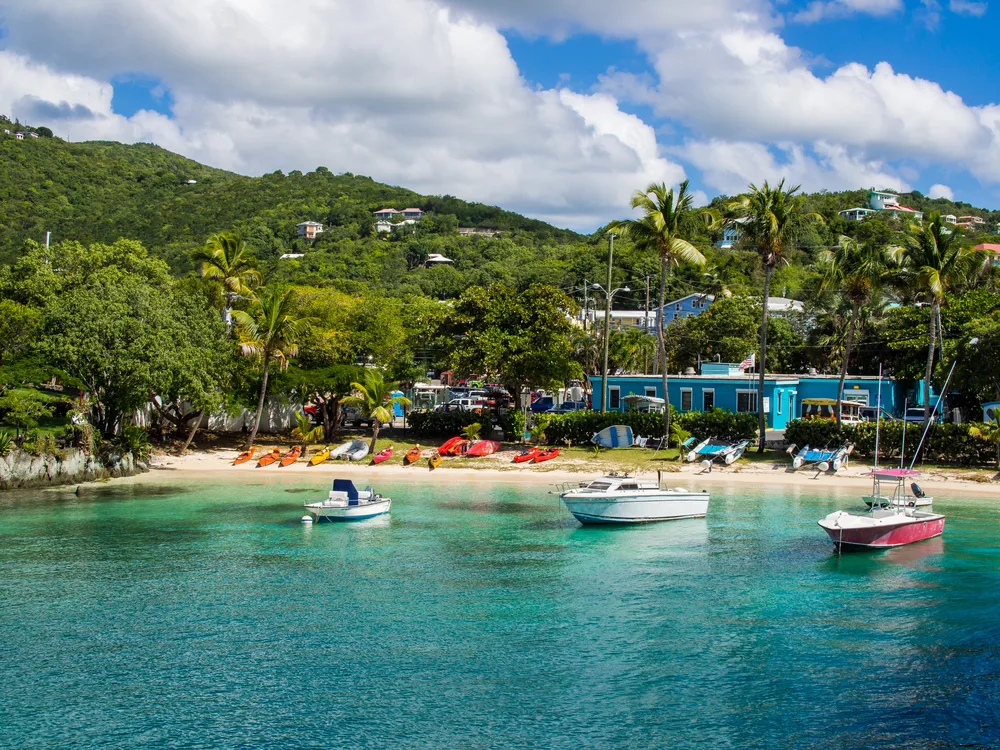
Jonathan A. Mauer/Shutterstock
The best time to visit St. John is between December and April (excluding March, which is the most expensive month). This period is the dry peak season with excellent weather for enjoying the beaches, snorkeling, excursions in the national park, and waterfront dining and bars.
Come between August and October if you want the cheapest prices, but note that it’s the rainy hurricane season with higher chances of storms and hurricanes. July and November may be better options for similarly low prices and less storm risk.
We like the months of May, June, and July for their less-crowded conditions (it’s still rainy at times), but recommend avoiding March (most expensive month of the year for hotels and flights) and September (most of St. John’s historic hurricanes hit this month).
St. John can offer you a tropical place of peace, adventure, and scenery year-round. But now that you’re equipped with the best, cheapest, and least busy times to visit, you can take the guesswork out of your trip and ensure everything’s as dreamy as it seems when you arrive!



